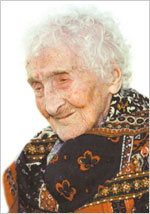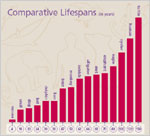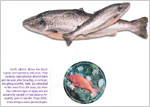| |
 |
| |
Jeanne Calment |
In 1965, a lawyer made an unusual deal with one of his older clients, Jeanne Calment of Arles, France. In exchange for ownership of her apartment, he agreed to pay her a monthly pension for the rest of her life. Because Mme. Calment was 90 years old at the time, it seemed likely that the lawyer would only have to make a few payments before her demise. As it turned out, however, it was a much better bargain for Mme. Calment. During the next 32 years of her extraordinary life, she was paid three times the worth of the apartment.
“We all make bad deals in life,” Mme. Calment once joked to the astounded attorney. When her well documented life ended on August 4, 1997 at age 122 years 5 months and 14 days, she is believed to have lived longer than any other person in recorded history. She outlived Shigechiyo Izumi of Japan, who had held the unverified longevity record of 120 years, 237 days. She outlived her husband, who died in 1942, four years before their 50th wedding anniversary. She outlived her daughter, who died in 1936. She outlived her only grandson, who died in 1963. And yes, she outlived her lawyer who died—at age 77—soon after Mme. Calment’s 120th birthday. Long lives like Mme. Calment’s are a wonder. Of the planet’s current 6 billion inhabitants, perhaps no more than 25 people are more than 110 years old. So these super centenarians, as they are known, are clearly humanity’s ultimate marathoners. But why? What factors allowed Jeanne Calment, who was 14 when the Eiffel Tower was completed and who once sold painting supplies to Vincent Van Gogh, to live such a long life that she herself became part of history? Is genetics the key factor? Mme. Calment’s ancestors were legendary for their long lives. Is it where people live? As of 2001, ten of the world’s oldest people were Japanese, six were American, three were French, and two were Italian. Is there something special about how these people live? Mme. Calment took up fencing lessons at 85, still rode a bicycle at age 100, smoked until she was 117, and ate a diet rich in olive oil all of her life. In truth, there probably is no single “secret” of aging. More than likely, all of these elements—heredity, environment, and lifestyle—have complex roles in determining whether an individual will have a long and healthy life, according to scientists who study aging.
| |
 |
| |
|
These scientists, called gerontologists, ponder other fundamental questions. Why do we age? What happens as we age? Why do some people age faster or slower and in different ways than others? Is there a maximum human lifespan beyond which we cannot live no matter how optimal our environment or favorable our genes? And finally for all of us, the most important question: How can insights into longevity be used to fight the diseases and disabilities associated with old age to make sure this period of life is healthy, active, and independent?
Researchers at the National Institute on Aging (NIA), part of the National Institutes of Health, are seeking answers to these and other important questions. Established by the Federal Government in 1974, the NIA conducts and supports research on aging and educates the public about its findings.
Aging Under the Microscope: A Biological Quest describes what we know so far about the answers to these questions. It offers an overview of research on aging and longevity, describing the major puzzle pieces already in place and, to the extent possible, the shapes of those that are missing.
What Is Aging? What Is Senescence?
Aging is a complex natural process potentially involving every molecule, cell, and organ in the body. In its broadest sense, aging merely refers to changes that occur during the lifespan. However, this definition includes some changes that aren’t necessarily problematic, and usually don’t affect an individual’s viability. Gray hair and wrinkles, for instance, certainly are manifestations of aging, but neither is harmful.
To differentiate these superficial changes from those that increase the risk of disease, disability, or death, gerontologists prefer to use a more precise term—senescence—to describe aging. Senescence is the progressive deterioration of many bodily functions over time. This loss of function is accompanied by decreased fertility and increased risk of mortality as an individual gets older. The rate and progression of this process can vary greatly from person to person, but generally over time every major organ of the body is affected. As we age, for instance, lung tissue loses much of its elasticity, and the muscles of the rib cage shrink. As a result, maximum vital breathing capacity progressively diminishes in each decade of life, beginning at about age 20. With age, blood vessels accumulate fatty deposits and lose much of their flexibility, resulting in arteriosclerosis or “hardening of the arteries.” In the gastrointestinal system, production of digestive enzymes diminishes, and as a result, tissues lose much of their ability to break down and absorb foods properly. In women, vaginal fluid production decreases and sexual tissues atrophy with increasing age. In men, sperm production decreases and the prostate enlarges.
Why these and other changes occur with advancing age both intrigues and perplexes gerontologists. In fact, senescence is one of nature’s least understood biological processes. Gerontologists, for instance, disagree about when senescence begins. Some argue it begins at birth. Others contend it sets in after the peak reproductive years. But clearly, senescence, whether it begins at birth or age 20, 30, or 40, leads to an accumulating loss of bodily functions, which ultimately increases the probability of death, as we get older.
| |
 |
| |
|
What is the Difference Between Life Expectancy and Lifespan?
When George Washington celebrated his 60th birthday in 1792, he had outlived all of his male ancestors, dating back for several generations. He had outlived a typical Virginian of his era by about 15 years. To achieve this relative “old age,” he had survived smallpox, mumps, pneumonia, dysentery, typhoid fever, a staphylococcal infection of the hip, four bouts of malaria, and two nearly fatal encounters with influenza.
When Jeanne Calment was born in 1875, the illnesses that plagued Washington’s generation still took many lives, health care was still fairly primitive, and the life expectancy—the average number of years from birth that an individual can expect to live—was still less than 50 years worldwide.
Yet Mme. Calment, perhaps because she was born with a set of extraordinary genes or was simply fortunate enough to elude many of the illnesses that claim so many others, beat the odds and set the benchmark for maximum human lifespan—the greatest age reached by any member of a species.
Life expectancy in the United States rose dramatically in the 20th century, from about 47 years in 1900 to about 73 years for males and 79 years for females in 1999. This increase is mostly due to improvements in environmental factors—sanitation, the discovery of antibiotics, and medical care. Now, as scientists make headway against chronic diseases like cancer and heart disease, some think life expectancy can be extended even further in the 21st century.
As part of this quest, gerontologists are studying a variety of life forms including yeast, fruit flies, nematodes, mice, and primates in search of clues applicable to human aging. As they explore the genes, cells, and organs involved in aging, they are uncovering more and more of the secrets of longevity. As a result, life extension may some day be more than the stuff of myth. In addition, as gerontologists apply their expanding knowledge to medicine, the prevention or retardation of the onset of some age-related diseases and disabilities may become realistic goals.
| |
 |
| |
|
Why Do We Age?
Gerontologists have proposed many theories to explain the diversity of the aging process in nature. Pacific salmon, for instance, reproduce only once and die within hours of spawning, while at the other end of the spectrum, sea anemones, which reproduce asexually, show few, if any, outward signs of deterioration until the very end of their long lives. Most gerontologists now agree that no single theory can account for this wide spectrum. In fact, with the tools of biotechnology and an influx of new knowledge, all-encompassing theories of aging are giving way to a more diverse perspective.
Aging today is viewed as many processes, interactive and interdependent, that determine lifespan and health, and gerontologists are studying a multitude of factors that may be involved. The rest of this booklet describes what we know and don't know about many of these factors, and where we think scientists are likely to find answers to questions about aging and longevity.
| Theories of Aging |
|
Theories of aging fall into two groups. The programmed theories hold that aging follows a biological timetable, perhaps a continuation of the one that regulates childhood growth and development. The damage or error theories emphasize environmental assaults to our systems that gradually cause things to go wrong. Many of the theories of aging are not mutually exclusive. Here is a brief and very simplified rundown of the major theories.
PROGRAMMED THEORIES
Programmed Longevity. Aging is the result of the sequential switching on and off of certain genes, with senescence being defined as the time when age-associated deficits are manifested.
Endocrine Theory. Biological clocks act through hormones to control the pace of aging.
Immunological Theory. A programmed decline in immune system functions leads to an increased vulnerability to infectious disease and thus aging and death.
ERROR THEORIES
Wear and Tear. Cells and tissues have vital parts that wear out.
Rate of Living. The greater an organism's rate of oxygen basal metabolism, the shorter its life span.
Crosslinking. An accumulation of crosslinked proteins damages cells and tissues, slowing down bodily processes.
Free Radicals. Accumulated damage caused by oxygen radicals causes cells, and eventually organs, to stop functioning.
Somatic DNA Damage. Genetic mutations occur and accumulate with increasing age, causing cells to deteriorate and malfunction. In particular, damage to mitochondrial DNA might lead to mitochondrial dysfunction. |
<< Back | Next >>
